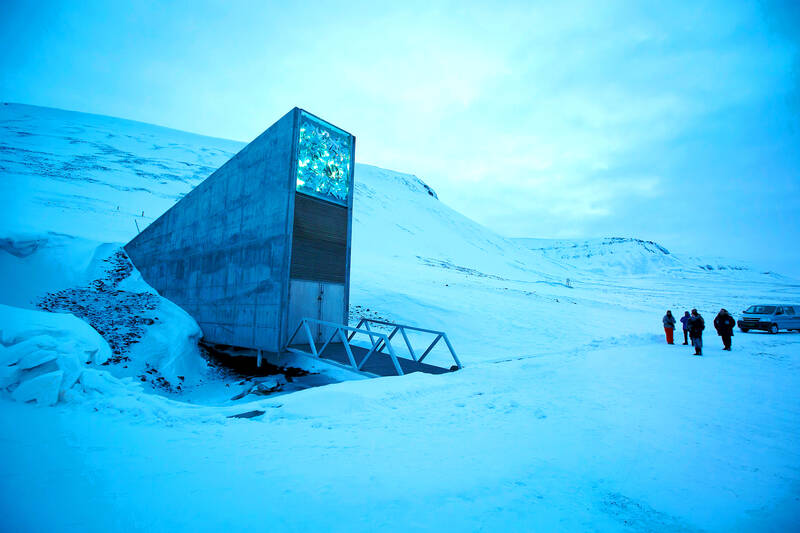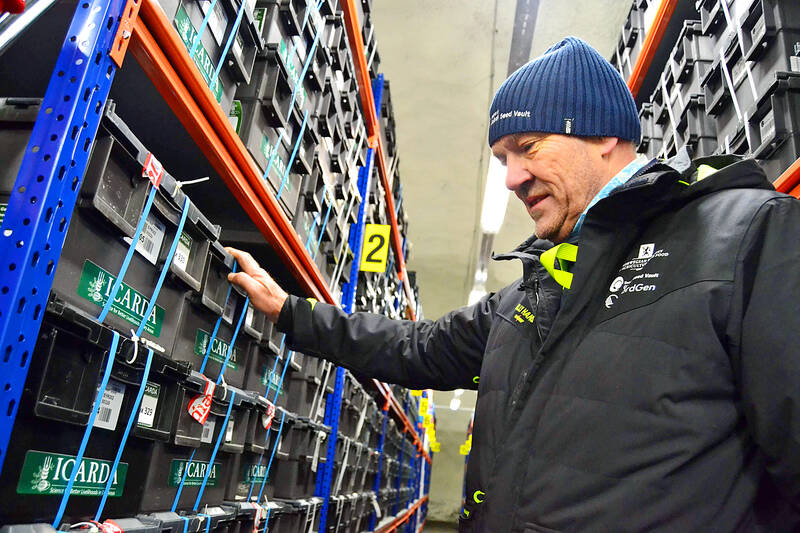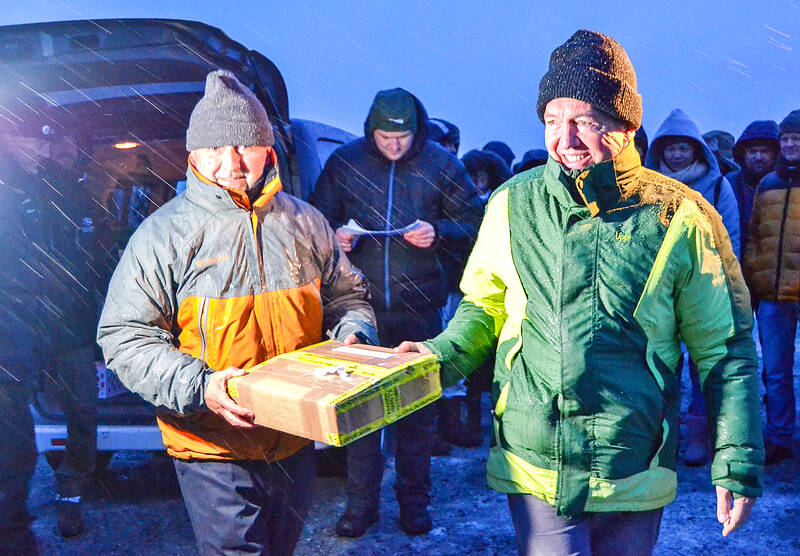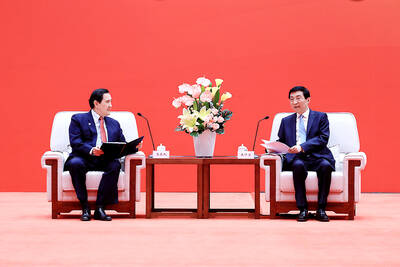“Are we allowed to go in?” I surprise myself with this question, given that I’m staring through the small window of a door into one of six underground vaults, each one essentially a walk-in freezer. The temperature inside is -20C. It is a grey winter day at the Millennium Seed Bank in Wakehurst, Sussex and the maze of featureless corridors and reinforced concrete adds to the 1984-ish austerity of the setting. These vaults are designed to withstand the worst apocalypse we can imagine — be it caused by bombs, radiation, floods or disease.
Elinor Breman, a senior researcher, and my guide for today, briefly hesitates before responding: yes, I can, but only if I sign a waiver and don’t have any heart conditions. This seems fair enough. I sign a declaration, having read the warnings of frostbite and hypothermia, and Breman hands me a protective blue coat. She flicks a switch before we go in. When I look at her quizzically, she casually explains that this is so an alarm goes off if we’re not out in five minutes.
Inside, the door shut behind us, I’m greeted by the one antidote we’d need in the face of impending annihilation: a larder lined with rows and rows of sealed glass jars full of seeds. This is the largest seed bank in the world — nearly 2.5 billion seeds are conserved here, ready for use in hundreds, if not thousands of years to come. Most seeds are frozen in these vaults, though a smaller number are cryopreserved instead and stored in vats of liquid nitrogen at -180C.

Photo: AFP
Fans whir, the cold presses in on me. Breman picks up a couple of jars, but she can’t tell me which seeds are inside — a barcode system is used to decipher them, yet another layer of security. In total, this facility is a backup for almost 40,000 wild plant species worldwide. After about two minutes, and with my fingertips tingling, we make our exit.
Built in 2000, this seed bank is one of as many as 1,700 worldwide, otherwise known as ‘“doomsday vaults”: facilities intended to safeguard humanity in the event of civilization’s collapse. It isn’t just about seeds — researchers are preserving everything from DNA to data, and even feces. Should it all go wrong, these Noah’s Arks could provide the blueprints for our recovery.
‘INSURANCE POLICY’

Photo: AFP
As Breman puts it, the Millennium Seed Bank is an “insurance policy against extinction,” helping preserve the planet’s rapidly declining biodiversity. And the outlook is bleak: two in five plant species are facing extinction according to one report by Royal Botanic Gardens, Kew, which also coordinates this project. The main causes are, invariably, human practices — industrial farming, deforestation, pollution, climate change and so on. Yet humans depend on plants for food, medicines, clothing, building materials and, quite literally, the oxygen we breathe.
“You could look at it as an altruistic thing, but it is also actually survival,” adds Breman. “We need these plants to survive.”
The concept of doomsday vaults began in the 1920s, when the Russian botanist Nikolai Vavilov set one up in what is now St Petersburg. It still exists today and during the World War II a number of its scientists purportedly died of hunger rather than eat the collection during the 28-month siege of Leningrad, all the while protecting it from starving citizens and encroaching German troops. Most vaults act like regular financial banks — you make a deposit, which is securely stored, and then you can withdraw it when you need it.

Photo: AFP
Yet while the doomsday name conjures up images of end-of-the-world events, many banks are already in use, for research purposes or to address more localized catastrophes already before us, such as war or natural disasters. The Millennium Seed Bank, for example, has been using its collection to restore chalk grasslands in the South Downs for more than a decade now, with other projects in Madagascar, Indonesia and Mexico. Seeds from Vavilov’s institute, meanwhile, were used to restore crops in the Soviet Union after the war.
In the frozen mountains of Svalbard, a remote archipelago between Norway and the North Pole, lies another doomsday vault, this one seeking to preserve the world’s data. Opened in 2017, the Arctic World Archive stores data on physical reels of film, owned by Norwegian company Piql, some 300 meters inside a decommissioned mine. The vault, says founder Rune Bjerkestrand, seeks to “help preserve world memory, irreplaceable information for the benefit of future generations.” In an era of cyber-attacks and misinformation, it is also concerned, he adds, with “making sure that it is done in a way where information and data cannot be manipulated, cannot be edited or changed according to any person or organization’s ideas.”
Over Zoom, Bjerkestrand holds up a strip of film, which is part of the vault’s collection. It appears transparent but, held against the light, and with Bjerkestrand’s arm as a backdrop, I can make out its contents: a tiny visualization of the Taj Mahal, representing a 3D scan of the monument by the Archaeological Survey of India. Also preserved in the vault is Sweden’s entire database of art, comprising some 140,000 pieces, a selection of manuscripts from the Vatican library, and a digitized version of Edvard Munch’s The Scream. In 2020, GitHub, the world’s largest source code host, announced it had stored 21TB of data on 186 reels of film at the vault.
As at the Millennium Seed Bank, security is paramount. The facility is alarmed and has video surveillance. Polar bears, says Bjerkestrand, act as security guards. (I let out a chuckle at this, but Bjerkestrand is serious. “You laugh, but a couple of years ago there was a Dutch guy taken for breakfast by a polar bear just a few hundred meters from the entrance of the vault.”) The land naturally lends itself to the preservation of the photosensitive film: the vaults are dry, dark and, thanks to the surrounding permafrost — permanently frozen ground — extremely cold.
So ideal is this island for preservation that it’s home to another bank, the Global Seed Vault. Opened in 2008 by the Norwegian government, it’s essentially the agricultural equivalent of the Millennium Seed Bank. With more than 1 million seed varieties, including rice, wheat and beans, it is a backup facility for crops vital to food production and is used as a secondary repository for long-term storage by other seed banks internationally. Like the Millennium Seed Bank, its importance is already proven: in 2015, researchers from a seed bank in Syria became the first to take out a deposit so as to restore their collections in Morocco and Lebanon, after fleeing the civil war.
PLANNING
When it comes to planning a vault, many considerations come into play. It must be a secure facility in somewhere as geopolitically stable as possible (Svalbard, for example, is remilitarized).
“The world is getting very complicated,” as Maria Gloria Dominguez-Bello, president of the Microbiota Vault, puts it, her point made by the tragedies of recent wars in the Middle East and Ukraine. Dominguez-Bello’s project, still in the early stages, seeks to preserve microbial biodiversity, including bacteria, fungi and viruses.
While some microbes are pathogens, others are beneficial to human health, helping with digestion and the prevention of illness, and it is these which the Microbiota Vault will seek to preserve by cryopreserving human feces.
“Microbiomes [the collection of all microbes that live in our body] are, for each one of the species of this planet, vital,” says Dominguez-Bello. Human practices, such as the overuse of antibiotics, threaten this equilibrium, she says.
Potential sites mooted so far include some old military bunkers in the Swiss Alps or somewhere in Norway. But cost, as is the case for other vaults, is a barrier. Dominguez-Bello estimates her vault would take “hundreds of millions” to make a reality.
“We need big money to make the project self-sustaining,” she admits. “Again, it’s a hard thing in the current world.”
Others are looking further afield — even to the moon. In 2021, engineers from the University of Arizona unveiled ambitious proposals for a solar-powered “lunar ark,” which would seek to cryopreserve seeds, sperm and egg samples and store them in a facility built into the moon’s lava tubes — networks of conduits formed by streams of lava billions of years ago. The idea is that the ark would protect the planet’s biodiversity should there be a sudden, cataclysmic event, such as a supervolcanic eruption or a major asteroid strike.
“Our current civilization is actually quite volatile,” says Jekan Thanga, a professor of aerospace and mechanical engineering at the university, who is leading the project. “But these kinds of events can really reshape Earth.”
Thanga stresses that vaults on Earth aren’t necessarily braced for catastrophes. Owing to climate change, the permafrost is melting on Svalbard and gene bank collections have been destroyed or looted in Iraq and Afghanistan. A few years ago, the Philippines’ national gene bank was flooded.
But Thanga’s plans look like they’d need some refining — currently the proposals seek to preserve just 50 samples from each species, via an estimated 250 rocket launches; this is a far cry from the practices at the Millennium Seed Bank where the ideal collection is made up of 10,000 seeds of each species. Don’t these proposals seem a bit, well, out of this world? Thanga admits it could be a challenge to make them a reality.
“Our sense is that with the cryopreservation units, optimistically, we need to be advancing all these fields within the next 30 years to really get there. And it’s by no means going to be low-cost here.”
FROZEN ARK
Back down on Earth, Brendon Noble is chair of the board of the Frozen Ark project which has so far cryopreserved some 48,000 samples of genetic material from endangered animals, totaling around 5,500 species, including honeybees, North Africa’s scimitar-horned oryx — now extinct in the wild — the Colombian spider monkey and the snow leopard. For Noble, their work is one of a “survival obligation” for humans. Animals and insects are key to the maintenance of our ecosystems, such as for pollination, food production and medicines.
But the situation is undeniably grim. Last year, a WWF report found that global wildlife populations had plummeted by 69 percent in the past 50 years, largely linked to human activities, from deforestation to poaching and industrial pollution.
“People are talking about the sixth great extinction and the fact that we’re in the middle of it, we’re not waiting for it,” he explains. “The fifth one actually got rid of the dinosaurs… The rate at which we’re losing species is just utterly astounding.”
If humanity is seemingly so ill-fated, isn’t there a temptation to just give up? Noble strongly disagrees.
“I think it’s really important to feel that we’re taking action,” he says. “We’re doing what we feel is a solid contribution to making things work.”
He looks to animals as a treasure trove of possibilities for humans — researchers have long studied the naked mole-rat, for example, because it doesn’t get cancer.
“There’s so many species in the world that have incredible powers, if you like characteristics, and the DNA is the blueprint,” says Noble. “Why wouldn’t we want to preserve that and understand it?”
The need for seed banks can feel bleak and yet Breman sees them as beacons for hope. “I think that everybody who works at the Millennium Seed Bank would say that what we’re doing is providing options for the future,” she says. “Every seed that’s banked here has the potential to help change the world.”

The canonical shot of an East Asian city is a night skyline studded with towering apartment and office buildings, bright with neon and plastic signage, a landscape of energy and modernity. Another classic image is the same city seen from above, in which identical apartment towers march across the city, spilling out over nearby geography, like stylized soldiers colonizing new territory in a board game. Densely populated dynamic conurbations of money, technological innovation and convenience, it is hard to see the cities of East Asia as what they truly are: necropolises. Why is this? The East Asian development model, with

Desperate dads meet in car parks to exchange packets; exhausted parents slip it into their kids’ drinks; families wait months for prescriptions buy it “off label.” But is it worth the risk? “The first time I gave him a gummy, I thought, ‘Oh my God, have I killed him?’ He just passed out in front of the TV. That never happens.” Jen remembers giving her son, David, six, melatonin to help him sleep. She got them from a friend, a pediatrician who gave them to her own child. “It was sort of hilarious. She had half a tub of gummies,

The wide-screen spectacle of Formula One gets a gleaming, rip-roaring workout in Joseph Kosinski’s F1, a fine-tuned machine of a movie that, in its most riveting racing scenes, approaches a kind of high-speed splendor. Kosinski, who last endeavored to put moviegoers in the seat of a fighter jet in Top Gun: Maverick, has moved to the open cockpits of Formula One with much the same affection, if not outright need, for speed. A lot of the same team is back. Jerry Bruckheimer produces. Ehren Kruger, a co-writer on Maverick, takes sole credit here. Hans Zimmer, a co-composer previously, supplies the thumping

There is an old British curse, “may you live in interesting times,” passed off as ancient Chinese wisdom to make it sound more exotic and profound. We are living in interesting times. From US President Donald Trump’s decision on American tariffs, to how the recalls will play out, to uncertainty about how events are evolving in China, we can do nothing more than wait with bated breath. At the cusp of potentially momentous change, it is a good time to take stock of the current state of Taiwan’s political parties. As things stand, all three major parties are struggling. For our examination of the